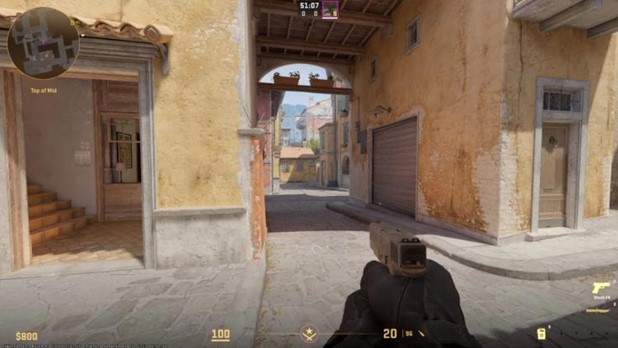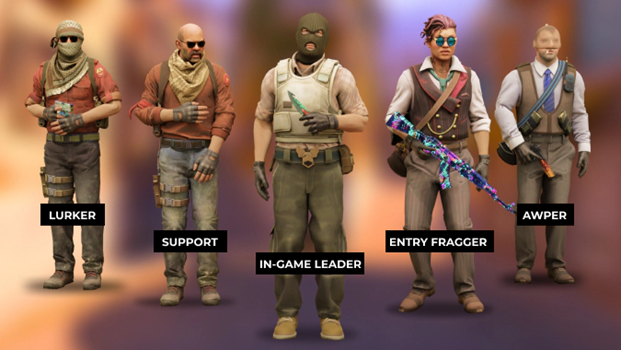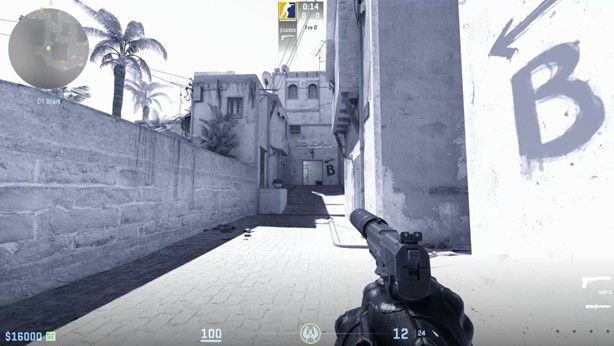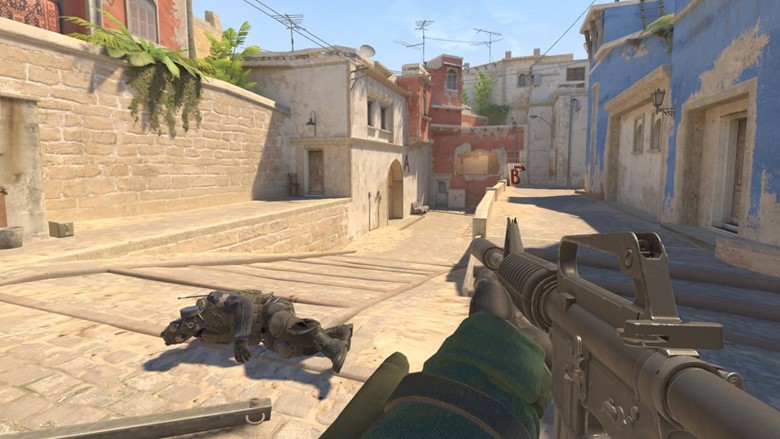
Counter-Strike, a staple in the gaming world for nearly two decades, offers both individual and team-based gameplay. Renowned for its complexity, it demands strategic acumen and tactical prowess from its players.
Counter-Strike 2 emphasizes the importance of synergy within teams. Success hinges on players fitting seamlessly into designated roles, enabling them to leverage their strengths and secure victories round by round.
Among these crucial roles, the Lurker stands out. While the term “lurker” may have varied interpretations elsewhere, its significance is clear. This article delves into the nuanced role of the lurker in CS2, offering a comprehensive understanding for enthusiasts.
Want the best skins for your cs2 weapons, check out wiki.cs.trade.
Exploring the Distinct Roles in CS2

Counter-Strike 2 thrives on teamwork and strategic gameplay, with each player assuming a distinct role vital for the team’s success. These roles not only provide structure but also ensure that every member contributes effectively towards achieving victory. Let’s delve into the intricacies of each role:
- Entry Fragger
At the forefront of the action stands the Entry Fragger, a pivotal role, particularly on the Terrorist (T) side. Tasked with initiating engagements by breaching enemy defenses, the Entry Fragger is akin to the vanguard of the team. This player requires agility and impeccable aim to swiftly overcome opponents. Moreover, they must exhibit composure amid intense firefights, as their actions often dictate the game’s momentum.
- AWPer
Stepping into the shoes of the AWPer unveils a realm of precision and finesse. Specializing in long-range combat, AWPers wield the iconic sniper rifle to eliminate adversaries from afar. These players are typically the cream of the crop, possessing exceptional proficiency with the AWP coupled with a serene demeanor essential for patiently picking off targets.
- Support
Amidst the spotlight-grabbing fraggers, the Support role silently plays a crucial part in bolstering team efforts. While lacking the sharpshooting prowess of Entry Fraggers or the marksmanship finesse of AWPers, Supports excel in aiding teammates and deploying utility items effectively. Whether it’s obscuring enemy vision with smoke grenades or disrupting their advance with flashbangs, Supports ensure tactical advantage for their squad.
- IGL
Serving as the tactical mastermind, the In-Game Leader (IGL) assumes the mantle of leadership both in and out of the game. This strategic linchpin dictates the team’s maneuvers and decision-making, orchestrating plays to outmaneuver opponents. A blend of intellect and competitive experience is requisite for this role, given its pivotal role in shaping the course of battles.
- Lurker
Lastly, we unravel the enigmatic figure of the Lurker, the focal point of our discussion. A Lurker embodies patience and precision, adopting a stealthy approach to support teammates from the shadows. With a keen eye and steady aim, they lurk on the fringes of battle, seizing opportunities to flank unsuspecting foes and disrupt enemy formations.
The Significance of Roles in CS2

Roles play a pivotal role in shaping the outcome of every match, particularly in the fiercely competitive and high-stakes arena of professional gaming. These roles delineate the specific duties and responsibilities of each player within a team, laying the groundwork for a cohesive and strategic approach to gameplay.
Essential Classifications
Within the realm of CS2, roles are neatly categorized into five distinct classes: Entry Fraggers, Support players, AWPers, IGLs and Lurkers. While the majority of players may gravitate towards roles such as Entry Fraggers or Lurkers, each role holds equal importance in orchestrating triumph on the battlefield.
Diverse Responsibilities, Unified Objective
Every role within CS2 comes with its unique set of responsibilities, demanding specialized skills and expertise from the players. Entry Fraggers, for instance, spearhead offensive maneuvers by initiating engagements and breaching enemy defenses with swift precision. Conversely, Support players excel in providing tactical assistance to their teammates, utilizing utility items like smoke grenades and flashbangs to gain strategic advantage.
Meanwhile, AWPers showcase their prowess in long-range combat, wielding the iconic sniper rifle to eliminate adversaries with pinpoint accuracy. IGLs, on the other hand, serve as the strategic architects of the team, orchestrating maneuvers and making critical decisions to outmaneuver opponents.
Lastly, Lurkers epitomize patience and precision, operating stealthily to flank adversaries and disrupt enemy formations from the shadows. Each role, though diverse in its approach, contributes synergistically towards the collective goal of team success.
A Symphony of Individual Brilliance and Team Coordination
The beauty of CS2 lies in its harmonious blend of individual brilliance and team coordination. While each player assumes a specific role tailored to their strengths and capabilities, success hinges on seamless coordination and collaboration within the team. Whether it’s the aggressive pushes of Entry Fraggers or the strategic maneuvering orchestrated by IGLs, every action is meticulously orchestrated to achieve victory.
Understanding the Role of the Lurker in Counter-Strike

In the intricate world of Counter-Strike, the role of the lurker often remains shrouded in misunderstanding. Yet, this position holds immense strategic significance, offering a unique approach to gameplay that can tilt the balance of a match in favour of the adept team.
Separation and Strategic Maneuvering
At its core, the lurker operates on the principle of detachment from the main team’s maneuvers. When the In-Game Leader orchestrates a push towards a particular site, such as A Site in Dust 2, the lurker ventures alone into alternative routes, often traversing through the middle or Lower, patiently awaiting the rotation of opponents.
Unpredictable Ambushes and Distractions
The essence of lurking lies in unpredictability. Lurkers thrive in surprising adversaries by occupying unexpected positions during rotations, catching opponents off guard with calculated ambushes. Moreover, they may employ tactics to distract enemies, such as creating noise in specific locations or gathering crucial intel to facilitate flanking maneuvers. In essence, the lurker embodies the archetype of a “silent assassin,” striking when least expected and paving the way for strategic advantages.
Adaptability and Self-Defense
Equipped with heavy weaponry like the AK-47 or SMGs, lurkers must be prepared to fend for themselves when confronted by one or two adversaries. This necessitates a blend of sharpshooting prowess and tactical positioning, allowing lurkers to hold their ground and potentially neutralize threats, thereby buying valuable time for their team to capitalize on the ensuing chaos.
Information Gathering and Tactical Insights
The positioning of lurkers holds paramount importance, as their observations and engagements furnish the IGL with critical information to inform strategic decisions mid-round. By relaying enemy movements and vulnerabilities, lurkers empower the IGL to devise nuanced tactics and adapt to evolving circumstances, thereby maintaining a competitive edge throughout the match.
How to Become a Good Lurker?

Becoming a proficient Lurker in Counter-Strike entails mastering a combination of tactical awareness, strategic positioning, and effective communication. This is how to hone your skills and excel in this pivotal role:
- Comprehensive Map Knowledge
Familiarize yourself with every nook and cranny of the map. This intimate understanding allows you to navigate stealthily and capitalize on unsuspecting opponents. Study common pathways, hiding spots, and potential ambush locations to maximize your effectiveness as a Lurker.
- Exercise Patience
Patience is the cornerstone of successful lurking. Resist the temptation to rush into engagements impulsively. Instead, bide your time, wait for opportune moments, and strike when the enemy is least prepared. Remember, a well-timed ambush can turn the tide of a match in your team’s favor.
- Effective Communication
Despite operating independently, communication remains paramount for Lurkers. Relay critical information to your teammates, including enemy positions, rotations, and potential threats. Clear and concise call-outs can facilitate coordinated maneuvers and enhance the team’s overall performance.
- Strategic Engagement
Choose your battles wisely. As a Lurker, your objective is to sow chaos and disrupt enemy formations. Opt for engagements where you have the element of surprise or favorable positioning. Avoid unnecessary confrontations that could jeopardize your stealthy approach.
- Continuous Practice and Observation
Mastery of the Lurker role comes with dedicated practice and observation. Analyze gameplay footage of professional Lurkers, dissecting their strategies and decision-making processes. Emulate their techniques in your own gameplay and refine your skills through consistent practice sessions.
- Adaptability and Flexibility
Remain adaptable in your approach. Every match presents unique challenges and opportunities, requiring you to adjust your tactics accordingly. Stay flexible in your movements, seamlessly transitioning between aggressive lurking and patient observation based on the evolving dynamics of the game.
Looking for a platform to trade your skins, you should visit cs.trade.
Conclusion
Becoming a skilled lurker is achievable by following the tips outlined in this article. Mastery of lurking can significantly impact your team’s performance, demanding strategic thinking, patience, and strong game sense. Other team members can adapt to the lurker role as required, emphasizing flexibility within CS2 team dynamics.
